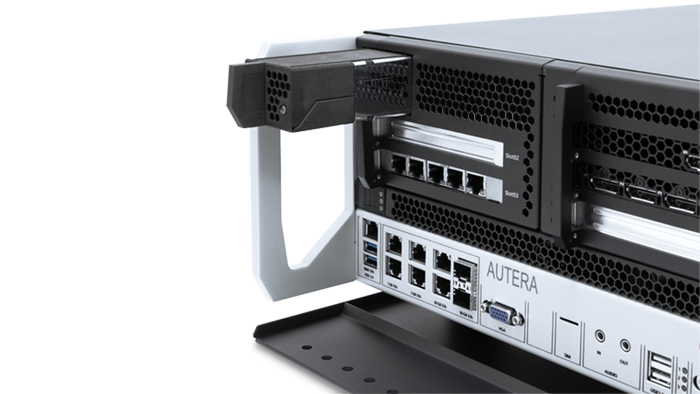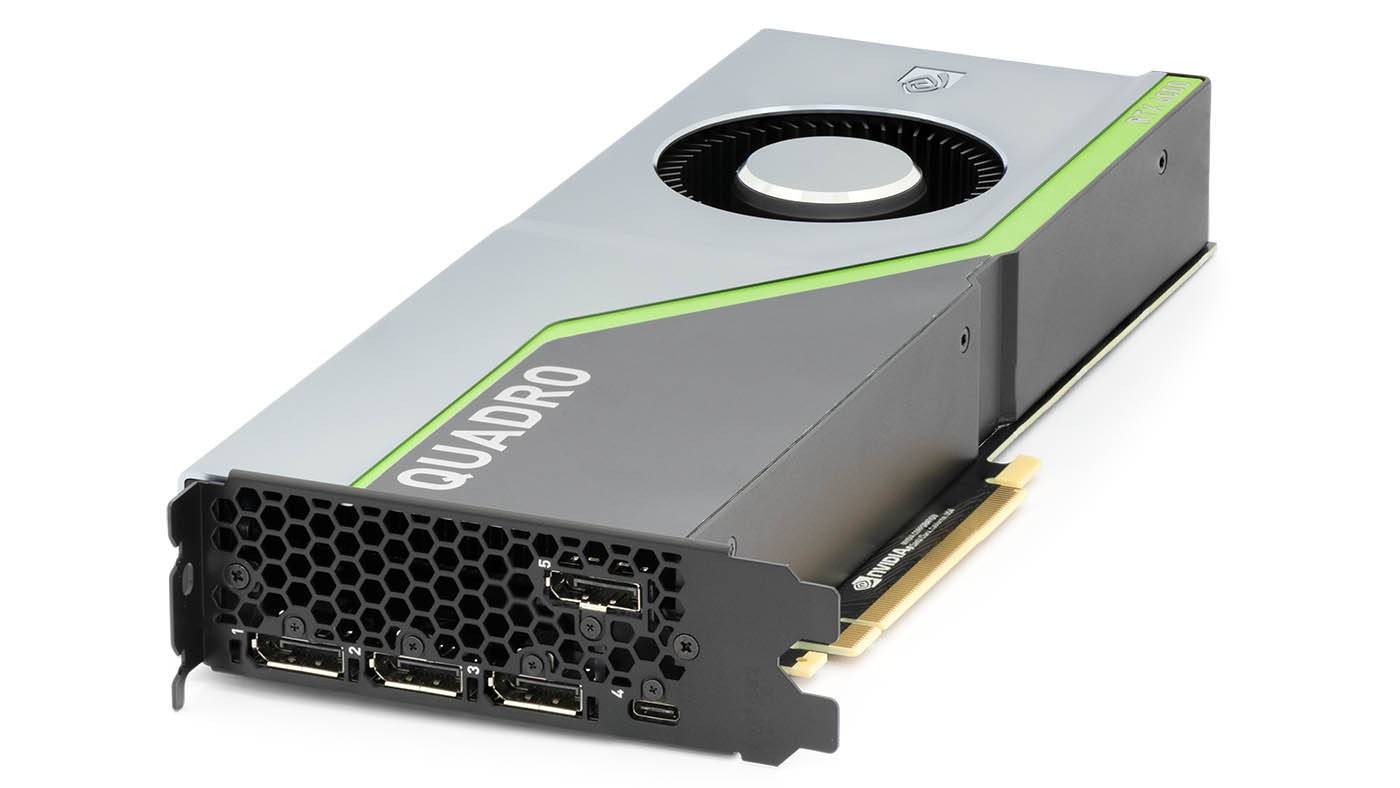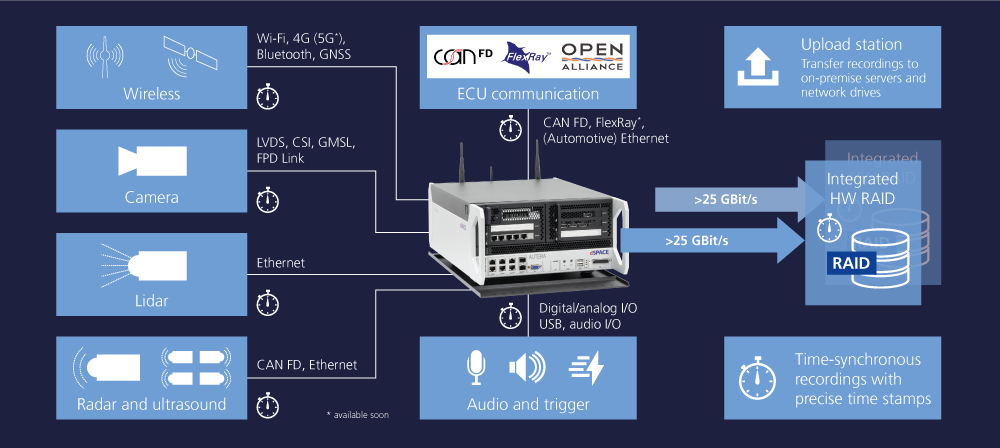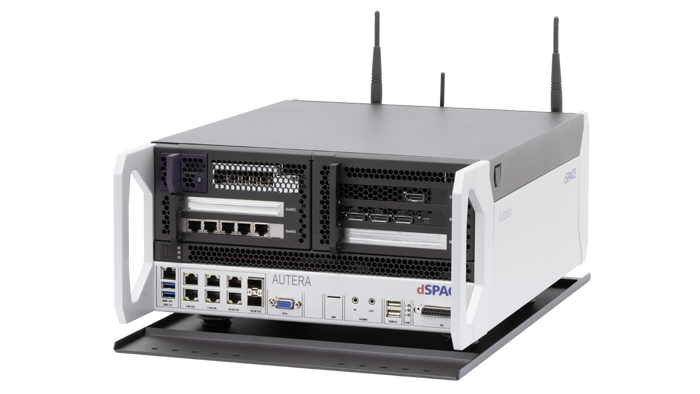Sensoren spielen in autonomen Fahrzeugen eine enorm wichtige Rolle und sie liefern immer größer werdende Datenströme. dSPACE stellt mit der AUTERA-Produktfamilie jetzt eine Systemlösung bereit, die Sensorrohdaten von beispielsweise Lidar-, Radar- und Kamerasensoren ebenso wie von automotiven Bussen und Netzwerken mit sehr hoher Bandbreite einlesen, verarbeiten und aufzeichnen kann.

Autonome Fahrzeuge verfügen über eine Vielzahl hochauflösender Sensoren, mit denen sie ihre Umgebung erfassen. Diese Sensoren liefern viele sehr große Datenströme, die möglichst effizient zu einem Gesamtumgebungsbild fusioniert werden müssen. Dieses steht für die weitere Trajektorienplanung zur Verfügung. Die Objekterkennung und Sensorfusion erfolgt dabei sehr häufig mit Hilfe künstlicher Intelligenz (KI). Um die komplexen KI-basierten Systeme zu entwickeln, zu trainieren und zu testen, sind enorm viele Daten (Petabytes) realer Messfahrten erforderlich.
Die Aufzeichnung aller relevanten Daten spielt daher eine elementare Rolle in diesem datengetriebenen Entwicklungsprozess. Die besondere Herausforderung dabei ist es, den ständig steigenden Bedarf an Bandbreite zu decken. Daher muss ein Aufzeichnungssystem nicht nur skalierbar sein, sondern es muss sich flexibel konfigurieren lassen, damit es an unterschiedliche Randbedingungen des Fahrzeugs wie Sensorschnittstellen, Busse und Netzwerke angepasst werden kann.
Neues System für Datenaufzeichnung, Verarbeitung und Replay
dSPACE bietet daher für die Datenaufzeichnung, das Prototyping im Fahrzeug und das spätere Abspielen der Daten im Labor eine neue extrem leistungsfähige Produktfamilie an: AUTERA. Der Name AUTERA steht für AUTonomous ERA und bezeichnet Produkte, die speziell für Entwicklungen in den Bereichen autonomes Fahren (AD) und Advanced Driver Assistance Systems (ADAS) ausgelegt sind.
Das erste System der neuen AUTERA-Produktfamilie ist die AUTERA AutoBox, ein robustes In-Vehicle-System für den Einsatz im Fahrzeug. DieAUTERA AutoBox ist genau das richtige System, um während Testfahrten umfangreiche Datenmengen unterschiedlicher Sensoren, automotiver Busse und Netzwerke aufzuzeichnen und zu verarbeiten. Dafür werden ne-
ben CAN FD, Ethernet (1000BASE-T, 10GBASE-T) und Automotive Ethernet (100/1000BASE-T1) auch verschiedene Rohdaten-Schnittstellen wie GMSL II, FPD Link III oder CSI II für Kamerasensoren unterstützt.
All diese Schnittstellen sind zeitlich synchronisiert und nehmen direkt beim Dateneingang präzise Zeitstempel auf, um die Daten anschließend auch zeitlich korrekt wieder abspielen zu können. Neben der Rechenleistung des Systems ist hierbei insbesondere auch die Bandbreite entscheidend, denn sie bestimmt, wie viele hochauflösende Sensoren gleichzeitig aufgenommen werden können. Die AUTERA AutoBox ist in der Lage, innerhalb eines kompakten Systems kontinuierlich bis zu 50 Gbit/s auf die einfach wechselbaren und Hot-Swapping-fähigen AUTERA-SSDs zu streamen. Sollte selbst diese extrem hohe Bandbreite einmal nicht mehr ausreichen, kann durch das Hinzufügen einer weiteren AUTERA AutoBox einfach skaliert werden. Die gespeicherten Daten lassen sich zu einem späteren Zeitpunkt wiedergeben (Replay) und zum Beispiel für das Training neuronaler Netze, die Szenariengenerierung und die Homologation nutzen.
Einsatzfertige Lösung
Die AUTERA AutoBox wird mit Linux als Betriebssystem ausgeliefert und enthält bereits alle notwendigen Treiber für die sofortige Inbetriebnahme. An Bord ist außerdem die Multisensorentwicklungsumgebung RTMaps, die mit einfachen grafischen Methoden komplexe Zusammenhänge beherrschbar macht und die Datenströme der angeschlossenen Sensoren per Diagramm visualisiert. Darüber hinaus bietet sie intuitive Möglichkeiten zur Fusion und Aufzeichnung von Daten. RTMaps ist jedoch nur eine von vielen Optionen. Das Linux-Betriebssystem der AUTERA AutoBox ist grundsätzlich auch kompatibel zu anderen Software-Lösungen wie dem Framework ROS (Robot Operating System). Zusätzlich wird zukünftig eine offene API bereitgestellt, mit der Kunden alle relevanten Schnittstellen und Services des Systems in ihrer eignen Software-Umgebung nutzen können.

AUTERA Is Flexibly Expandable
Eine der Stärken von AUTERA liegt in den vielfältigen Erweiterungsmöglichkeiten. Dadurch lassen sich Systeme so konfigurieren, dass sie ein breites Aufgabenspektrum abdecken: von der Datenaufzeichnung mit hochperformanten Speichern über das Proto-typing von KI-Algorithmen mit dedizierten Hardware-Beschleunigern wie Grafikprozessoren (GPUs) bis hin zum Abspielen der aufgezeichneten Daten.
Die Erweiterungsoptionen von AUTERA:
- Performante Hardware-Beschleuniger
Möchte man die Sensordaten schon bei der Aufzeichnung bearbeiten, lässt sich AUTERA mit sehr performanten Hardware-Beschleunigern, zum Beispiel basierend auf Grafikprozessoren (GPUs) oder zukünftig Field Programmable Gate Arrays (FPGAs), erweitern. Dadurch können beispielsweise schon während der Logging-Testfahrt Daten vorverarbeitet oder gelabelt werden. Das System lässt sich damit auch für die Entwicklung, Optimierung und Validierung von Perzeptions- und Fusionierungsalgorithmen sowie von neuronalen Netzen nutzen.
- Einfache Speichererweiterung
Die Daten werden auf einer dedizierten und hochperformanten AUTERA Solid State Disk (SSD) gespeichert, die im Betrieb sehr einfach ausgetauscht werden kann (Hot Swapping). Davon lassen sich bis zu zwei pro AUTERA AutoBox parallel betreiben, um Bandbreite und Speicherplatz zu verdoppeln. Darüber hinaus lassen sich mehrere AUTERA-Systeme synchron koppeln, so dass Speichergröße und Bandbreite je nach Bedarf skaliert werden können.
- Schnellster Upload zum Server
Um die aufgezeichneten Daten so schnell wie möglich in eine bestehende Server-Infrastruktur oder die Cloud zu laden, bietet dSPACE zukünftig eine dedizierte AUTERA Upload Station an. Diese kann bis zu zwei AUTERA-SSDs gleichzeitig auslesen und streamt die Daten beispielsweise per 100 Gigabit Ethernet direkt zum Data Center. Da-
rüber hinaus kann schon heute per LTE auch während der Aufzeichnungsfahrt direkt auf die AUTERA AutoBox zugegriffen werden, um erste Daten direkt abzurufen. Zukünftig wird dieser Zugriff auch per 5G möglich sein.
- Einfaches Flottenmanagement
Die Verwaltung und das Update der Konfiguration einer größeren Fahrzeugflotte zur Datenaufzeichnung ohne zentralen Zugangspunkt sind häufig aufwendig und kompliziert. Daher wird dSPACE zukünftig auch eine Web-basierte Lösung für die Verwaltung der AUTERA-AutoBox-Systeme im Fahrzeug anbieten. Mit Hilfe dieser Lösung lässt sich von einem zentralen Arbeitsplatz der aktuelle Status des Systems überwachen, der Fehlerzustand erkennen und die aktuelle Position der AUTERA AutoBox ermitteln. Zu einem späteren Zeitpunkt kann dann auch die Konfiguration des Systems zentral aktualisiert und auf die gesamte Flotte ausgerollt werden.
Steckbrief: AUTERA
Einordnung: Data Logger, Replay- und Prototyping-System für Multisensoranwendungen
Schlüsselfunktionen
- Leistungsstarkes, erweiterbares System, das die Leistung eines Linux-Servers in einem robusten Gehäuse für
den Einsatz im Fahrzeug bietet - Synchrone Verarbeitung und Datenaufzeichnung von Umgebungssensoren und automotiven Bussen
- Flexibel erweiterbar durch Hardware-Beschleuniger für Datenvorverarbeitung und -fusionierung
- Hot-Swapping-fähige AUTERA-SSD für einfachen Speicheraustausch während einer Messfahrt
- Unterstützung von Rohdatenschnittstellen für Bildsensoren wie GMSL II, FPD-Link III oder CSI II
- Offenes System mit intuitiver grafischer Software-Umgebung RTMaps zur blockbasierten Implementierung
von Algorithmen oder der Option zur Nutzung offener APIs
Anwendungsfälle für AUTERA
Data Logging
- Einfahren von Referenzdaten
- Fahrzeug- und Steuergerätetests
Prototyping
- Sensorfusion
- Perzeption
Data Replay
- Validierung der AI-Algorithmen


